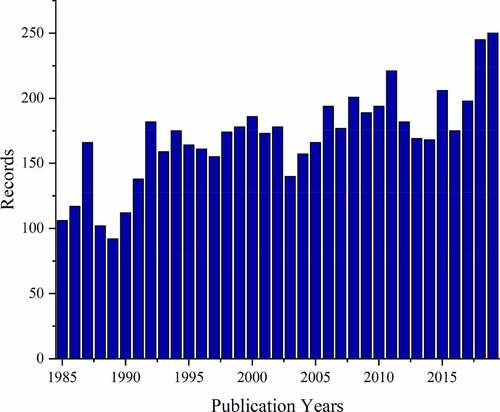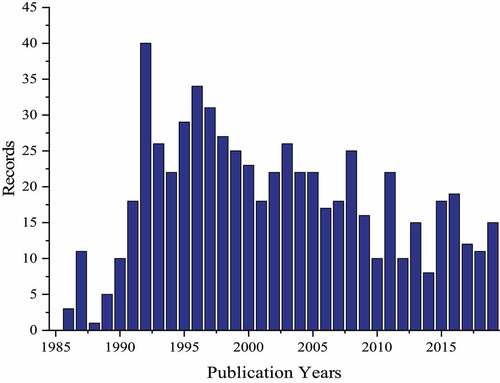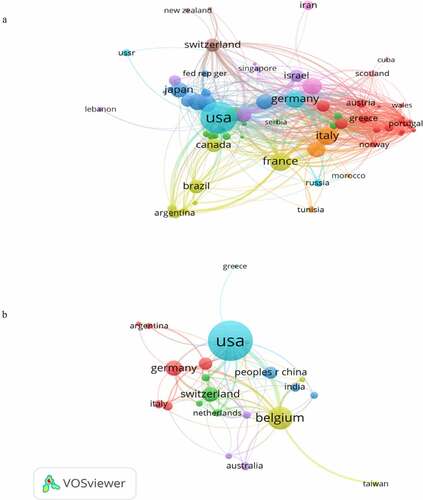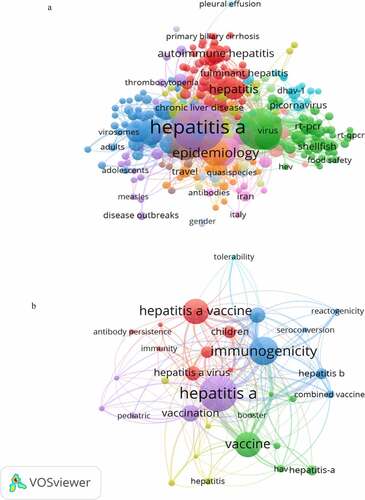ABSTRACT
Objective
A bibliometric analysis was conducted to build an all-inclusive view of the status of research on hepatitis A virus (HAV) for facilitating researchers, health professionals, and policymakers to understand the characteristics of research output in this particular domain.
Methods
A comprehensive search was conducted in the Web of Science database. The obtained data were exported into Microsoft Excel 2019, OriginPro 2018 and VOSviewer software for windows.
Results
From 1985 to 2019, a total of 5,950 studies on HAV were published, with an overall h-index of 105, and 90,350 total citations. The most cited article on HAV was “Classification of chronic viral hepatitis: a need for reassessment” authored by Scheuer in the Journal of Hepatology with a total of 1,121 citations. The most cited article on HAV vaccine was “A controlled trial of a formalin-inactivated hepatitis A vaccine in healthy children” by Werzberger et al. in the New England Journal of Medicine with 401 citations. The most frequent year of publication was 2019 (n = 250). The largest number of studies were funded by the United States Department of Health Human Services (n = 199). The organization with the highest number of publications was the United States Centers for Disease Control and Prevention (n = 228). The United State of America (n = 1,500) was the country with the most publications. ‘Vaccine’ was the leading journal with 299 publications.
Conclusions
The highest numbers of studies were published in developed countries. There is a clear need for interdisciplinary research approaches to evaluate and intervene in HAV endemic areas.
Introduction
Hepatitis A virus (HAV) is the causative agent of acute inflammation of the liver. Generally, the disease is self-limited.Citation1 Every year approximately 1.4 million cases of HAV are reported worldwide. According to World Health Organization (WHO), most children (90%) have been infected with the HAV before the age of 10 years, most often without symptoms in low- and middle-income countries.Citation2
Based on the sero-prevalence of anti-HAV immunoglobulin G (IgG) antibody HAV endemicity is classified into low (<15%), intermediate (15–50%), and high (>50%) levels. In low resources countries (most of Africa and parts of Asia, Eastern Europe and South America) with poor sanitation and hygienic conditions HAV infection is highly endemic. Generally, in developed countries (Australia, Japan, North America, and Western Europe) with good hygienic practices and sanitation system the risk of HAV infection is low. However, in countries with very low prevalence the risk of HAV infection is high among persons who inject drugs and men who have sex with men.Citation1–4
The disease is transmitted via the fecal/oral route through contaminated water and food.Citation3 Close contact with infected person with HAV is the most important mode of disease acquisition.Citation1 Common symptoms of HAV include fever, abdominal pain, nausea, fatigue, vomiting, and jaundice. The onset of symptoms usually appears 2–6 weeks after exposure to HAV.Citation5 HAV transmission can be prevented through improved sanitation and personal hygiene, and vaccination.Citation4 Administration of a single dose of vaccine elicits protective levels of antibodies in almost 100% of people within one month after injection. Inactivated HAV vaccine has not been reported to cause any serious adverse effects in millions of people after being vaccinated. WHO put forward a suggestion to include HAV vaccine in regular childhood immunization programmes and to vaccines for travelers. At present, 34 countries used or were planning to introduce HAV vaccine in routine immunization of children in specific risk groups.Citation4 In several resources limited countries, in the last two decades, the number of HAV cases have been declined due to improved socioeconomic condition, personal hygiene, sanitation and as a result of vaccination.Citation1
Rationale
Bibliometric studies are conducted not only to present an overview of the published scientific literature but also subjective and critical summarization of selected scientific studies/publications.Citation6–9 The bibliometric studies can be divided in to three categories; evaluative techniques, review techniques, and relational techniques.Citation10,Citation11
Objective
The aim of this study was to undertake a comprehensive bibliometric analysis on HAV research to obtain a coherent picture of the research output and scientific collaborations in the field and help in the process of planning and policymaking to direct research in preventing, treating and reducing morbidity and mortality.
Methods
A bibliometric analysis study was designed. Web of Science (WoS), Core Collection database is one of the most frequently used databases for bibliometric studies.Citation12 Hence, a comprehensive search was conducted in the WoS on January 06, 2020 (updated in February–March, 2021). The search key terms “Hepatitis A” contained in the title field was used. In addition, published literature on HAV vaccine was obtained using the search key terms “Hepatitis A” AND “vaccine” contained in the title field.
The search was limited to time period (1985-2019), and document types (article, review, meeting abstract, letter, proceedings paper and editorial material). Two investigators (Tauseef Ahmad and Taha H. Musa) independently extracted the required data and assessed the study eligibility. A number of attributes were extracted from the included studies including study title, author names, citations, publication year, journal name, document type, category, funding source, organization and country.
The obtained data were exported into Microsoft Excel 2019, OriginPro 2018 and VOSviewer software version 1.6.15 (https://www.vosviewer.com/) for windows. The results were presented in the form of frequency and percentage. The visualization network mapping (co-authorship countries and co-occurrence author keywords) was constructed using VOSviewer software.
Results
Characteristics of retrieved studies on HAV
A total of 5,950 publications were included in final analysis, with an overall h-index of 105, and 90,350 total citations. h-index is a number that represents the productivity as well as the impact of a scientist. It is a count of the number of publications for which an author has been cited at least that same number of times. The top-10 studies on HAV are presented in .
Table 1. Top-10 most cited studies in HAV research
Year of publication
The most frequent year of publication was 2019 (n = 250), followed by 2018 (n = 245), and 2011 (n = 221) as shown in .
WoS categories
The top-10 WoS categories are presented in . Gastroenterology hepatology was the leading category (n = 1,340 records), followed by infectious diseases (n = 925 records), and virology (n = 803).
Table 2. Top-10 WoS categories in HAV research
Document types
Of the total retrieved records, article was 3,952, followed by meeting abstract (n = 1,089), and letter (n = 508) as described in .
Table 3. Document types
Funding source
shows information about top-10 funding sources in HAV research. The largest number of studies were funded by the United States Department of Health Human Services (n = 199), followed by National Institutes of Health (NIH) United States of America (USA) (n = 166), and National Institute of Allergy Infectious Diseases (NIAID), USA (n = 101).
Table 4. Top-10 funding sources in HAV research
Most prolific authors
Of the total authors, only two authors published at least 50 studies. The leading author was Lemon SM (n = 81), followed by Bell BP (n = 50), and Flehmig B (n = 49) as shown in .
Table 5. Top-10 prolific authors in HAV research
Most productive countries
shows top-10 most productive countries in HAV research. USA was at the top of the list with 1,500 publications, followed by France (n = 379) and Germany (n = 352).
Table 6. Top-10 productive countries in HAV research
Publication languages
English was the most common language (n = 5,531), followed by Russian (n = 133), and French (n = 125) as presented in .
Table 7. Distribution of top-5 publication languages in HAV research
Most productive organizations
The organization with the highest number of publications was Centers for Disease Control and Prevention (CDC), USA (n = 228), followed by University of North Carolina (n = 103), and University of Barcelona (n = 101) as shown in .
Table 8. Top-10 productive orgnizations in HAV research
Most attractive journals
‘Vaccine’ was the leading journal with 299 publications, followed by ‘Hepatology’ (n = 297), and ‘Journal of Medical Virology’ (n = 206) as shown in .
Table 9. Top-10 attractive journals in HAV research
Chracteristics of studies on HAV vaccine
A total of 631 publications on HAV vaccine were analyzed. The most frequent year of publication in HAV vaccine was 1992 (n = 40) as shown in . An uncertainty was noticed among published articles in terms of publication year. The majority of the published materials was articles (426), followed by meeting abstracts (n = 70), letters (n = 68), proceeding papers (n = 54), editorial material (n = 37), and reviews (n = 20). The USA was the most productive country with 214 publications followed by Belgium (n = 93), Germany (n = 52), Switzerland (n = 48), and China (n = 35). Safary A was the most productive author with 39 published documents followed by Van Damme P (n = 24), and Herzog C (n = 20) as shown in . ‘Vaccine’ was the leading journal with 131 publications in HAV vaccine. Publications on HAV vaccine were cited 10,311 times, ranging from 1 to 431 citations (16.34 average citations per item) with h-index 47. The most cited article on HAV vaccine was “A controlled trial of a formalin-inactivated hepatitis A vaccine in healthy children” by Werzberger et al. in the New England Journal of Medicine with 401 citations. Top-10 most cited studies on HAV vaccine are presented in .
Table 10. Top-10 authors, top-10 countries, and document types in HAV vaccine research
Table 11. Top-10 most cited studies in HAV vaccine research
Comparison of top-10 publishing countries in HAV research
Distribution of the research output of top 10 countries in 06 blocks of 10 years each indicates that only 324 papers were produced in the first block (1985–1989) as compared to 803 papers produced in the last block (2015–2019). The main contributors among these countries were the USA, France, Germany, Italy and England. In order to study the growth of research activities among the top 10 countries during the period 1985 to 2019, we applied Transformative Activity Index (TAI).Citation12
Mathematically, TAI = [(Ci/Co)/(Wi/Wo)] × 100 where Ci is the number of publications of the specific country in the i-th block, Co is the total number of publications of the specific country during the period of study, Wi is the number of publications of all countries in the i-th block and Wo is the number of publications of all the countries during the period of study. The values of TAI for different countries are given in .
Figure 3. Change in the values of the Transformative Activity Index (TAI) for top 10 countries in 06 blocks of 10 years each indicates. TAI = 100 reflects that research output/effort of a country in the given field corresponds precisely to the world average, TAI>100 indicates higher than average, and TAI<100 represents lower than the average
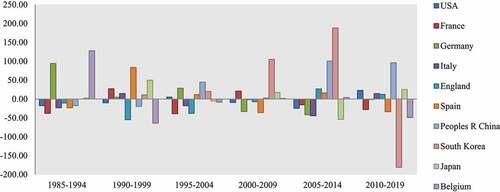
Co-authorship countries
Maximum number of countries per document was set at 25, while minimum number of documents per country was fixed at 5. Of the 130 countries, 74 meet the thresholds. shows that the USA was the leading county (documents = 1371, citations = 28595, total link strength = 350), followed by Germany (documents = 311, citations = 5307, total link strength = 312), and Belgium (documents = 206, citations = 4892, total link strength = 299) in HAV research. In addition, of the total countries involved in HAV vaccine research, only 24 meet the threshold. The most productive country was USA (documents = 190, citations = 3,459, total link strength = 66) as shown in .
Co-occurrence author keywords
Minimum number of co-occurrence of a keyword was fixed at 10. Of the total 4,211 keywords, only 117 keywords meet the threshold. The most frequent keyword was “hepatitis A” with 808 occurrences (total link strength 1,527), followed by “hepatitis A virus” (occurrences = 540, total link strength = 899), and vaccination (occurrences = 204, total link strength = 460) in HAV research as shown in . In addition, of the 569 keywords in HAV vaccine research, only 32 meet the threshold. Minimum number of co–occurrence of a keyword was set at 5. Hepatitis A, immunogenicity, hepatitis A vaccine, and vaccine were most widely used author keywords as shown in .
Discussion
A large number of studies on diagnosis, treatment, control and prevention of HAV have been conducted by researchers worldwide.Citation13–15 However, to the best of our knowledge, no particular studies on bibliometric analysis of HAV research are available, despite the significant role bibliometric studies play in providing a referral point for researches, policy-makers and medical practitioners. The present study focused on analyzing the global research output on HAV and HAV vaccine research during the period 1985–2019. The study documented the most dynamic authors and countries, most frequent WoS categories, most productive journals, and most cited studies in HAV research. There have been an increasing number of published items in the last decade with most papers published in 2019, owing to rise in the global burden of HAV infections, that is documented to rise by 4.2% between 2005 and 2015.Citation16
Our study is in agreement with many other bibliometric studies in different fields, and confirms USA was the global research leading country regarding the quality and quantity of published articles.Citation17–19 This high productivity can be attributed to economic strength, accessibility to research facilities, adequate funding, and a high level of collaboration with other institutions that leads to better research visibility and citation frequency. This is followed by the countries in Europe including United Kingdom (UK), France, Italy and Germany. From Asia, People’s Republic of China is among the most prolific, as is also evident from many other studies in different fields.Citation20,Citation21 This predisposition of publishing does not concord with the geographical distribution of virus as it is more common in low- and middle-income countries. This publishing trend is a reflection of quantum of HAV research being done in developing countries and raises a concern for the funding agencies working on control and prevention of HAV to support research in low-/middle-income countries.
Our study illustrates that prevailing collaborations occurred among authors and organizations from USA, France, Germany and Italy. Associations between developing and developed countries are infrequent in a number of scientific areas.Citation22 This limited contribution of the authors from low- and middle-income countries, especially in Asia, is evident from the available data. This trend is visible from many previous studies from various fields.Citation23–25
As is the case with other research areas, most of the leading authors in the HAV research field were from developed nations such as USA, Japan, Germany, Spain, and Belgium, with no one from low-income countries, thus follow the similar trend of low productivity of the region in other research areas. Most frequently cited studies pertained to identification and control of the HAV and are case studies. The most frequently cited keywords and research areas linked with HAV studies are a reflection of the research focus during the survey period. It included HAV, epidemiology and different types of infections linked with this virus. The study shows that many important topics necessary for disease management such as identification and detection of viruses were not revealed from the bibliometric analysis. Journals are an important tool for dissemination of research and the quality of journals play a role in effective transmission of research. ‘Vaccine’ was the leading journal in hepatitis A research.
This study will not only provide a point of reference for researchers and medical practitioners but will prove to be a baseline for policy makers to devise effective prevention and control strategies to combat HAV. More research is needed to be done in this field and researchers especially from disease burdened countries should be encouraged to research and share their findings in peer reviewed journals.
Conclusions
The present bibliometric study presents a global research scenario on HAV. It shows greater research output from high-income countries. A limited trend of collaboration with developing countries exhibited by technologically advanced and developed countries and low productivity in developing countries in HAV research is a reflection of the state of affairs in other research fields. A better understanding of the clinical features, epidemiology and hepatitis A associated diseases is required in countries with high infection rates. Low- and middle-income countries need to be supported through funding and by collaborating with them to upgrade the technical skills of researchers.
Disclosure of potential conflicts of interest
No potential conflicts of interest were disclosed.
Author’s contributions
TA: Conceived the idea, and designed the study; TA and THM: Conducted the search, and collected the data; TA: Wrote the first draft of manuscript; TA and SN: Software and formal analysis; TA, MAM, SN, THM, MB, and JH: Reviewed and edited the final draft. All the authors read and approved the final manuscript for publication.
Acknowledgments
We acknowledge the support of Southeast University Online Library for providing free access to Web of Science, Core Collection database.
Data availability statement
All the data are presented in this article and can be accessed through https://webofknowledge.com/.
Additional information
Funding
References
- Aggarwal R, Goel A. Hepatitis A: epidemiology in resource-poor countries. Curr Opin Infect Dis. 2015;28(5):488–96. doi:10.1097/QCO.0000000000000188.
- Jacobsen KH, Wiersma ST. Hepatitis A virus seroprevalence by age and world region, 1990 and 2005. Vaccine. 2010;28(40):6653–57. doi:10.1016/j.vaccine.2010.08.037.
- World Health Organization (WHO). The immunological basis for immunization series: module 18: Hepatitis A. WHO, Department of Immunization, Vaccines and Biologicals CH-1211 Geneva 27, Switzerland; 2019 [accessed 2021 Mar 20]. https://apps.who.int/iris/bitstream/handle/10665/44570/9789241501422_eng.pdf;jsessionid=0375458544B33B90766940350BB2F440?sequence=1
- World Health Organization (WHO). Hepatitis A. WHO; 2020. [accessed 2020 Mar 03]. https://www.who.int/news-room/fact-sheets/detail/hepatitis-a.
- Linder KA, Malani PN. Hepatitis A. JAMA. 2017;318(23):2393. doi:10.1001/jama.2017.17244.
- Fabregat-Aibar L, Barberà-Mariné MG, Terceño A, Pié L. A bibliometric and visualization analysis of socially responsible funds. Sustainability. 2019;11(9):2526. doi:10.3390/su11092526.
- Ahmad T, Nasir S, Musa TH, AlRyalat SAS, Khan M, Hui J. Epidemiology, diagnosis, vaccines, and bibliometric analysis of the 100 top-cited studies on Hepatitis E virus. Hum Vaccin Immunother. 2020;17(3):857–71. doi:10.1080/21645515.2020.1795458.
- Musa TH, Ahmad T, Li W, Kawuki J, Wana MN, Musa HH, Wei P, Bibliometric A. Analysis of global scientific research on scrub typhus. Biomed Res Int. 2020;2020:5737893. doi:10.1155/2020/5737893.
- Ahmad T, Murad MA, Baig M, Hui J. Research trends in COVI-19 vaccie: a bibliometric analysis. Hum Vaccin Immunother. 2021. Epub ahead of print. doi:10.1080/21645515.2021.1886806.
- Benckendorff P, Zehrer A. A network analysis of tourism research. Ann Tour Res. 2013;43:121–49. doi:10.1016/j.annals.2013.04.005.
- Koseoglu MA, Rahimi R, Okumus F, Liu J. Bibliometric studies in tourism. Ann Tour Res. 2016;61:180–98. doi:10.1016/j.annals.2016.10.006.
- Guan J, Ma N. A comparative study of research performance in computer science. Scientometrics. 2004;61(3):339–59. doi:10.1023/b:scie.0000045114.85737.1b.
- Heiat M, Ranjbar R, Alavian SM. Classical and modern approaches used for viral hepatitis diagnosis. Hepat Mon. 2014;14(4):e17632. doi:10.5812/hepatmon.17632.
- Amado Leon LA, de Almeida AJ, de Paula VS, Tourinho RS, Villela DAM, Gasper AMC, Lewis-Ximenez LL, Pinto MA. Longitudinal study of hepatitis A infection by saliva sampling: the kinetics of HAV markers in saliva revealed the application of saliva tests for hepatitis A study. PLoS ONE. 2015;10(12):e0145454. doi:10.1371/journal.pone.0145454.
- Lemon SM, Walker CM. Hepatitis A virus and hepatitis E virus: emerging and re-emerging enterically transmitted hepatitis viruses. Cold Spring Harb Perspect Med. 2019;9(6):a031823. doi:10.1101/cshperspect.a031823.
- Global Burden of Disease Study. Global, regional, and national incidence, prevalence, and years lived with disability for 310 diseases and injuries, 1990–2015: a systematic analysis for the Global Burden of Disease Study 2015. Lancet. 2016;388(10053):1545–602. doi:10.1016/S0140-6736(16)31678-6.
- Nasir S, Ahmed J, Asrar M, Gilani A-H, Bibliometric A. Analysis of pharmacy/pharmacology research in Pakistan. Int J Pharmacol. 2015;11:766–72. doi:10.3923/ijp.2015.766.772.
- Zhang X, Estoque RC, Xie H, Murayama Y, Ranagalage M. Bibliometric analysis of highly cited articles on ecosystem services. PLoS ONE. 2019;14(2):e0210707. doi:10.1371/journal.pone.0210707.
- Zhang W, Tang N, Li X, George DM, He G, Huang T. The top 100 most cited articles on total hip arthroplasty: a bibliometric analysis. J Orthop Surg Res. 2019;14(1):412. doi:10.1186/s13018-019-1476-3.
- Nasir S, Ahmed J, Bibliometric A. Analysis of research on Zika virus indexed in Web of Science. Adv Life Sci. 2018;5:88–95.
- Lin GX, Kotheeranurak V, Mahatthanatrakul A, Ruetten S, Yeung A, Lee SH, Ahn Y, Kim H-S, Hofstetter C, Lee J-H, et al. Worldwide research productivity in the field of full-endoscopic spine surgery: a bibliometric study. Eur Spine J. 2020;29:153-60. doi:10.1007/s00586-019-06171-2.
- Vanni T, Mesa-Frias M, Sanchez-Garcia R, Roesler R, Schwartsmann G, Goldani MZ, Foss AM. International scientific collaboration in HIV and HPV: a network analysis. PLoS ONE. 2014;9(3):e93376. doi:10.1371/journal.pone.0093376.
- Liu X, Liu N, Zhou M, Lu Y, Li F. Bibliometric analysis of global research on the rehabilitation of spinal cord injury in the past two decades. Ther Clin Risk Manag. 2018;15:1–14. doi:10.2147/TCRM.S163881.
- Sweileh WM. A bibliometric analysis of global research output on health and human rights (1900–2017). Glob Health Res Policy. 2018;3:30. doi:10.1186/s41256-018-0085-8.
- Chang L, Su Y, Zhu R, Duan Z. Mapping international collaboration in tuberculosis research from 1998 to 2017. A scientometric study. Medicine. 2019;98(37):e17027. doi:10.1097/MD.0000000000017027.

